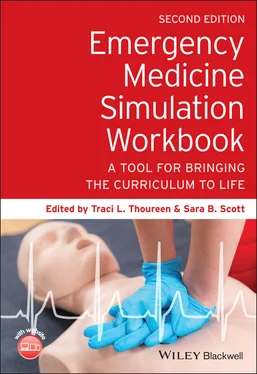Emergency Medicine Simulation Workbook
Здесь есть возможность читать онлайн «Emergency Medicine Simulation Workbook» — ознакомительный отрывок электронной книги совершенно бесплатно, а после прочтения отрывка купить полную версию. В некоторых случаях можно слушать аудио, скачать через торрент в формате fb2 и присутствует краткое содержание. Жанр: unrecognised, на английском языке. Описание произведения, (предисловие) а так же отзывы посетителей доступны на портале библиотеки ЛибКат.
- Название:Emergency Medicine Simulation Workbook
- Автор:
- Жанр:
- Год:неизвестен
- ISBN:нет данных
- Рейтинг книги:3 / 5. Голосов: 1
-
Избранное:Добавить в избранное
- Отзывы:
-
Ваша оценка:
- 60
- 1
- 2
- 3
- 4
- 5
Emergency Medicine Simulation Workbook: краткое содержание, описание и аннотация
Предлагаем к чтению аннотацию, описание, краткое содержание или предисловие (зависит от того, что написал сам автор книги «Emergency Medicine Simulation Workbook»). Если вы не нашли необходимую информацию о книге — напишите в комментариях, мы постараемся отыскать её.
Emergency Medicine Simulation Workbook
Emergency Medicine Simulation Workbook — читать онлайн ознакомительный отрывок
Ниже представлен текст книги, разбитый по страницам. Система сохранения места последней прочитанной страницы, позволяет с удобством читать онлайн бесплатно книгу «Emergency Medicine Simulation Workbook», без необходимости каждый раз заново искать на чём Вы остановились. Поставьте закладку, и сможете в любой момент перейти на страницу, на которой закончили чтение.
Интервал:
Закладка:
Medications:0.9% saline/LR IV bags.Pre‐labeled IV bags:Broad‐spectrum antibiotics.Pre‐labeled syringes:Analgesic medications (e.g. morphine, fentanyl, hydromorphone)Antiemetics (e.g. metoclopramide, ondansetron)Antipsychotics (typical of your institution examples include haloperidol, risperidone, etc.)Benzodiazepines (lorazepam, diazepam, midazolam).Optional: emesis basin.
Distractor: The patient's behavior is a distractor and the learner must demonstrate de‐escalation and redirection techniques to obtain history and physical exam.
Actors
Patient has chronic, poorly controlled schizophrenia. He is uncooperative and agitated with all the questioning and will require redirection and verbal de‐escalation throughout the scenario. He is difficult to obtain history from, stating: “I am sick of answering all these questions.” Eventually he will comply with the team's treatment plan (i.e., IV access, imaging, etc.).
ED nurse is experienced and can cue the learners as needed.
EMS may be an actor or may provide report via the phone (as a radio call from the field).
General surgery consultant available via phone consultation.
Case Narrative
Scenario Background
A 50 year‐old‐man presents with worsening abdominal pain for the past two days. It is associated with intractable nausea and vomiting. He has not had a bowel movement for the past three days, which is unusual for him. His group home called because he has been vomiting and his pain is getting worse. He has no reported fever, chest discomfort, shortness of breath, or urinary difficulties.
| Patient's medical history: | Paranoid schizophrenia, hypertension, anxiety. |
| Surgical history: | Hernia repair, tonsillectomy as a child. |
| Allergies: | haloperidol. |
| Medications: | Risperidone, trazodone, lorazepam. |
| Social history: | Previous cigarette smoker, no alcohol or drug use. Patient lives in a group living environment. |
| Family history: | Non‐contributory. |
Initial Scenario Conditions
A 50 year‐old man lying on a hospital stretcher is moaning in pain. Patient is occasionally retching into a basin.
| Vital signs: | T 98.7°F (37.1°C), P 115, RR 14, BP 110/60, SpO 299% on room air. |
| Head: | Atraumatic, normocephalic. |
| Eyes: | Pupils equal and reactive, extraocular muscles intact. |
| Ears/nose/mouth: | Dry mucous membranes. |
| Neck: | Supple, full range of motion, no meningismus. |
| Heart: | Tachycardic, regular, no murmurs/rubs/gallops. |
| Lungs: | Clear to auscultation bilaterally, no wheezes/rales/rhonchi. |
| Abdomen: | Distended, with hyperactive bowel sounds. Tender to palpation in all quadrants, no rebound/guarding/rigidity. Moans with deep palpation. |
| Extremities: | No edema, cyanosis, or clubbing. |
| Skin: | Warm and well‐perfused, no rashes. |
| Neurologic: | Alert and oriented to self, place, and time. No focal deficits. Cranial nerves intact. No nystagmus. |
| Psychiatric: | Patient very rude and uncooperative, with agitated affect. Denies SI/HI/active hallucinations. |
See flow diagram ( Figure 1.21) for scenario changes based on learner actions.
Case Narrative, Continued
For all learners, the case should begin with obtaining a complete history, and performing a thorough physical exam. The nurse can help the learners to set the patient up on the monitor.
The learners should order laboratories, imaging studies, and appropriate medications (such as IV fluids, antiemetics, and pain control).
Throughout the scenario, the patient will be very disagreeable to the plan of care. He will be difficult to obtain history from and will be angry during the examination, “because that hurts me!” He will also initially refuse IV access and will require discussion about why this is necessary. He will then become hostile about the possibility of needing a CT scan because, “Aren't you a doctor? Can't you just figure it out based on what I've told you?” Ultimately he will require multiple efforts at verbal de‐escalation before agreeing.
After the learner discusses the diagnosis of volvulus and the need for surgical evaluation with the patient, he will become upset and frustrated. He will calm down if the learner takes the time to listen to him and acknowledge his frustrations.
The trigger for the end of the case will be consultation with surgery for intervention and admission.
Instructor Notes
Epidemiology
Third leading cause of large bowel obstruction worldwide, following cancer and complications of diverticulitis [1].
Risk factors:Elderly.Individuals with chronic constipation and/or a high fiber diet.Nursing home or long‐term care facility patients [2], including patients with chronic psychiatric disorders and dementia.
Pathophysiology
Sigmoid colon becomes stretched, attachments to the abdominal wall loosen, allowing colon to twist.
Ischemia occurs, which can progress to gangrene and perforation.
Clinical Features
Common symptoms:Abdominal pain.Bloating.Constipation/obstipation.Nausea/vomiting (may be feculent).
Exam findings:Pain on palpation.Abdominal distension.High‐pitched bowel sounds.
Diagnosis
Lab tests not diagnostic.
Imaging:Abdominal radiographs:Distended loops of colon with or without air‐fluid levels“Bent inner tube sign” of distended colon in a U‐shaped pattern and extending from the pelvis toward the right upper quadrant.Paucity of gas in the rectum.Free air under the diaphragm, if perforation has occurred.Abdominal CT:Dilated loops of bowel with evidence of obstruction.“Whirl sign” or twisting of the mesentery.“Bird's beak” sign if rectal contrast has been given.Absence of gas in the rectum.Transition point within the bowel.Late findings that may indicate bowel necrosis or perforation: pneumatosis intestinalis, portal venous gas, loss of bowel wall enhancement.
Management
Analgesia.
Antiemetics.
IV fluid resuscitation.
IV antibiotics:Recommended for signs of peritonitis, perforation or sepsis.
Emergent surgical consultation:Flexible sigmoidoscopy.Recommended initial treatment strategy.Can be both diagnostic and therapeutic unless patients have perforation or significant ischemia.Laparotomy:If detorsion with endoscopy is not able to be performed, may be required.
Debriefing Plan
Provide approximately 20–30 minutes for debriefing after this scenario.
Potential Questions for Discussion
What are some helpful strategies for dealing with difficult patients or patients with behavioral issues?
What are risk factors for sigmoid volvulus?
What abnormalities can be seen on abdominal x‐ray in a patient with sigmoid volvulus?
What is the management for a patient diagnosed with sigmoid volvulus? Is surgery always required?
REFERENCES FOR SIGMOID VOLVULUS
1 1. Bauman, Z.M. and Evans, C.H. (2018). Volvulus. Surg. Clin. North Am. 98 (5): 973–993.
2 2. Gingold, D. and Murrell, Z. (2012). Management of colonic volvulus. Clin. Colon Rectal Surg. 25 (4): 236–244.
Читать дальшеИнтервал:
Закладка:
Похожие книги на «Emergency Medicine Simulation Workbook»
Представляем Вашему вниманию похожие книги на «Emergency Medicine Simulation Workbook» списком для выбора. Мы отобрали схожую по названию и смыслу литературу в надежде предоставить читателям больше вариантов отыскать новые, интересные, ещё непрочитанные произведения.
Обсуждение, отзывы о книге «Emergency Medicine Simulation Workbook» и просто собственные мнения читателей. Оставьте ваши комментарии, напишите, что Вы думаете о произведении, его смысле или главных героях. Укажите что конкретно понравилось, а что нет, и почему Вы так считаете.












